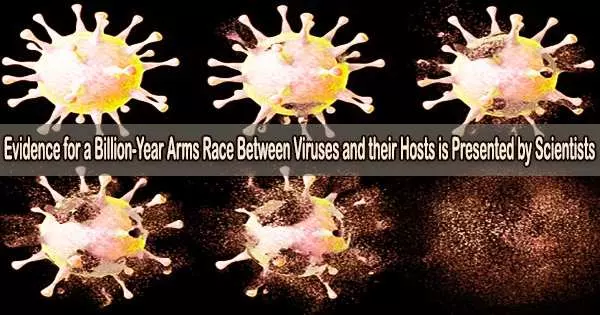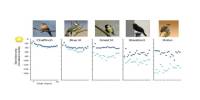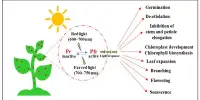A new evolutionary theory that suggests a billion-year evolutionary arms race between two groups within the virus kingdom known as Bamfordvirae and their hosts has been put forth by researchers to explain the formation of this category of viruses.
Our knowledge of the complex evolutionary history of viruses, their interactions with the earliest eukaryotes (organisms with cells that include a nucleus), and the diversification of viral lineages has been advanced by their study, which was just published as a Reviewed Preprint in eLife.
One of the most varied groups of pathogens that infect living things is the kingdom Bamfordvirae. They include the Nucleocytoplasmic Large DNA viruses (NCLDVs; the largest viruses characterized to date), virophages (viral parasites of other viruses), adenoviruses (common viruses that cause cold and flu-like symptoms), and Mavericks and Polinton-like viruses (both virus-like mobile genetic elements that colonize the genomes of their hosts).
The ‘nuclear-escape’ and ‘virophage-first’ hypotheses are the two main theories regarding where these viruses came from. The Maverick-like ancestor originated with hosts (endogenous), fled from the host cell nucleus, and gave rise to adenoviruses and NCLDVs, according to the nuclear-escape hypothesis.
The virophage-first hypothesis, on the other hand, contends that NCLDVs co-evolved with early virophages. Mavericks then developed from virophages that turned endogenous, and adenoviruses later broke out from the host nucleus.
As well as playing important roles in Earth’s ecosystems, it is becoming increasingly clear that viruses may have contributed to major evolutionary transitions during the history of life. Therefore, understanding the deep evolutionary history of viruses provides more context for these ancient interactions and the actors involved.
José Gabriel Niño Barreat
“Despite these proposed scenarios, the diversification of viruses in the Bamfordvirae kingdom remains a major open question in virus evolution. To gain a better understanding of their history, we wanted to test the predictions made by both the nuclear-escape and virophage-first models, and consider alternative scenarios regarding the origin of different lineages,” says José Gabriel Niño Barreat, Postdoctoral Research Assistant at the University of Oxford, UK.
Barreat is a co-author of the study alongside Aris Katzourakis, Professor of Evolution and Genomics at the University of Oxford’s Department of Biology.
Barreat and Katzourakis used two hypothesis-testing methods (maximum-likelihood and Bayesian frameworks) to compare the plausibility of the nuclear-escape versus alternative evolutionary scenarios. They concentrated on four essential proteins that are involved in the construction of viral capsids and are shared by viruses in this lineage: main and minor capsid proteins, DNA-packaging ATPase, and protease.
They used two additional techniques that estimate rooted phylogenies using genomic data in order to determine the evolutionary history of the various lineages. Then, they evaluated whether, as suggested by the nuclear-escape scenario, adenoviruses and NCLDVs descended from a shared ancestor.
Their analyses provided substantial evidence against the nuclear-escape hypothesis’s prediction of a sister relationship between adenoviruses and NCLDVs. Instead, the data imply that, in contrast to NCLDVs, adenoviruses shared an ancestor with Mavericks.
The researchers discovered that the most recent common ancestor of Mavericks and adenoviruses was not a virophage, contradicting a virophage-first hypothesis. The virophage-first theory is still the one that current phylogenetic analyses most strongly support because of their work.
Furthermore, the position of the Bamfordvirae ancestral root between virophages and other viral lineages is supported by their studies. This location led the team to a novel theory for the viral evolutionary history.
“The model proposes that the Bamfordvirae ancestor did not originate from an invasion of the eukaryotic cell nucleus, and that it was a non-virophage DNA virus with a small genome,” says co-author Aris Katzourakis. “The lifestyle of virophages would have evolved at a later stage as these became specialized parasites of the ancestral NCLDVs.”
According to Katzourakis, the relative chronology of events indicates that the Bamfordvirae kingdom’s most recent common ancestor lived more than a billion years ago, going back to the earliest phases of eukaryotic life. However, there is yet no exact timeframe for the precise chronology of these occurrences.
Another drawback of the study is the possibility that the lineage’s tremendous diversity and profound divergences concealed the phylogenetic signal in the protein data that was examined. However, the authors were able to clearly discriminate between competing hypotheses, and the emphasis on the evolution of the viral capsid offers a clear explanation for the observed data.
“This work contributes to our knowledge on how viruses evolve different evolutionary strategies, for example to become parasites of other viruses like virophages, or viral giants like NCLDVs,” Barreat says.
“As well as playing important roles in Earth’s ecosystems, it is becoming increasingly clear that viruses may have contributed to major evolutionary transitions during the history of life. Therefore, understanding the deep evolutionary history of viruses provides more context for these ancient interactions and the actors involved.”
“Unraveling the interactions between viruses and their hosts provides a window into the deep evolutionary past that is illuminating the origins of both of these biological entities,” Katzourakis concludes.
















